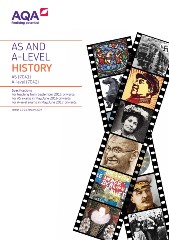1G Challenge and transformation: Britain, c1851–1964
This option allows students to study in breadth issues of change, continuity, cause and consequence in this period through the following key questions:
- How did democracy and political organisations develop in Britain?
- How important were ideas and ideologies?
- How and with what effects did the economy develop?
- How and with what effects did society and social policy develop?
- How and why did Britain's relationship with Ireland change?
- How important was the role of key individuals and groups and how were they affected by developments?
Part one: Victorian and Edwardian Britain, c1851–1914
Reform and challenge, c1851–c1886
- The political system: parliament and the workings of mid-19th century democracy; ruling elites; prime ministers; parties and party realignment to 1867
- Political developments under Gladstone and Disraeli; liberalism, conservatism and the bases of their support; the extension of the franchise
- Economic developments: agriculture, trade and industry; economic ideologies; boom and 'the workshop of the world'; the onset of Depression
- Society and social changes: class and regional division; prosperity and poverty
- Social movements and policies; self-help; trade unions; education and social reform legislation
- The condition of Ireland and Anglo-Irish relations: land agitation and the political response; Home Rule
Challenges to the status quo, c1886–1914
- Political developments: the reasons for Conservative dominance to 1905; the problems of the Liberal Party; socialism, Fabianism and the emergence of the Labour Party
- Politics 1906–1914: the ideology of New Liberalism; political crises and constitutional change; development of the Labour Party
- Economic developments: the Great Depression and its aftermath; problems of British industry and agriculture; staples and new industries, foreign competition; invisible exports; debates over protectionism, tariff reform and free trade
- Social change; trade unions and new unionism; syndicalism; the issue of female emancipation; the growth of the urban population; the expansion of service industries; standards of living
- Social policies: government legislation and local initiatives; taxation and welfare reform by 1914
- The condition of Ireland and Anglo-Irish relations: the Home Rule movement, opposition and the Home Rule Bills
Part two: The World Wars and their legacies: Britain, 1914–1964 (A-level only)
The Great War and its impact, 1914–1939 (A-level only)
- The impact of war on British parties and politics: coalition government; the decline of the Liberals; position of Conservatives and influence of Labour
- Political developments in the interwar years: electoral reform; Conservative and Labour governments; National governments; the abdication crisis and emergence of radical political movements, including the BUF and Communism
- Economic developments: increased state role in wartime; problems of the staple industries and mines; the General Strike; government finances and the Gold Standard; the Depression; economic realignment
- Social developments: changes in the role of women during and after war; the condition of the working classes; regional divisions; changing attitudes in the twenties and 'the hungry thirties'; the growth of the media
- Social policies: legislation and reforms in housing; education and welfare
- The condition of Ireland and Anglo-Irish relations: the Easter Rising; the Anglo-Irish War; Government of Ireland Act and Anglo-Irish Treaty; divided Ireland before the Second World War
Transformation and change, 1939–1964 (A-level only)
- The impact of the Second World War on British politics: Churchill as wartime leader; ‘the Labour landslide’ of 1945; Labour ideology and policies
- Political developments: Conservative dominance from 1951 and political consensus; division within the Labour Party; Conservatism and the Establishment; Labour victory in 1964
- Economic developments: mobilisation of resources in wartime; post-war boom; balance of payments issues and 'stop-go' policies; changes to British industry and trade; new technology
- Social changes and divisions: austerity and the impact of war; post-war boom and growth of affluence; consumerism and changes in position of women and youth; immigration and racial tensions
- Developments in social policy: the Beveridge Report; the Butler Act; the growth of the Welfare State, including the NHS; the growth of education
- The condition of Ireland and Anglo-Irish relations: continuing north/south friction including riots of September 1964; beginnings of civil rights campaign
